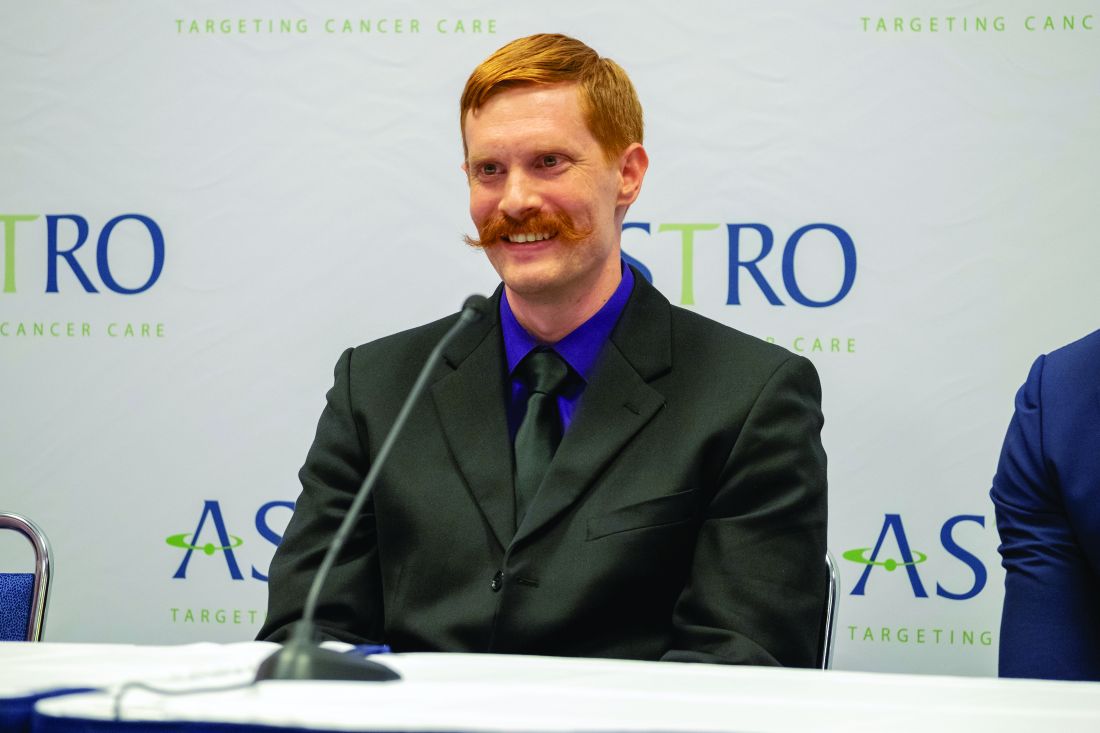User login
Hormone therapy may do more harm than good for men with low PSA before early salvage radiation
For men with prostate cancer who have a low prostate-specific antigen (PSA) level prior to salvage radiation therapy (SRT), adding an antiandrogen may increase the risk of other-cause mortality by twofold or more, according to investigators.
This finding was drawn from a secondary analysis of the NRG Oncology/RTOG 9601 phase 3 trial, a practice-changing study that showed that 2 years of antiandrogen therapy with bicalutamide improved overall survival when added to SRT, compared with that of SRT alone.
Results from the present analysis paint a more complex picture, revealing that patients with low PSA levels who received hormone therapy had a higher rate of other-cause mortality, primarily because of high-grade cardiac and neurologic events, reported lead author Daniel Spratt, MD, of the University of Michigan Rogel Cancer Center, Ann Arbor, who presented findings at the annual meeting of the American Society for Radiation Oncology.
Dr. Spratt described how treatment paradigms have changed since RTOG 9601 began in 1998, which prompted a revisitation of the trial. “Almost half of the men [in the trial] had a persistently elevated PSA after they underwent their initial surgery,” Dr. Spratt said. “This is uncommonly seen today. Additionally, about 60% of patients received what we call late salvage radiation therapy, where PSA was monitored and continued to rise beyond 0.5 [ng/mL]; again, this is not what is recommended to be used today.”
In the present analysis, the investigators stratified patients by PSA level. Of the 760 men involved, 85% had a PSA of 0.2-1.5 ng/mL. Patients were further subgrouped by those with a PSA of 0.2-0.6 ng/mL and those with a very low PSA, of 0.2-0.3 ng/mL. Multiple endpoints were assessed, including overall survival, other-cause mortality, distant metastasis, and rates of grade 3-5 cardiac or neurologic events.
The analysis showed that men with a PSA greater than 1.5 ng/mL had improved survival (hazard ratio, 0.45; 95% confidence interval, 0.25-0.81) when treated with bicalutamide, but those with PSA of 1.5 ng/mL or less did not (HR, 0.87; 95% CI, 0.66-1.16). Looking more closely at patients with a PSA of 1.5 ng/mL or less, those with a PSA of 0.2-0.6 ng/mL had a twofold increased rate of other-cause mortality (subdistribution HR, 1.94; P = .009). The picture became even more concerning for patients with a PSA of 0.2-0.3 ng/mL who were treated with bicalutamide: They had a fourfold increased risk of other cause mortality (sHR, 4.14). Among the cases with elevated other-cause mortality, grade 3-4 cardiac and neurologic events were likely to be blamed.
“What is likely driving this, and of concern, is that for [patients with a] PSA of less than 1.5 [ng/mL] … there was a three- to four-and-a-half-fold increased risk of high grade cardiac events,” Dr. Spratt said.
“The current guidelines recommend that all men be offered hormone therapy when receiving salvage radiation therapy, but our data demonstrate that men with lower PSA’s are probably more harmed than helped by long-term hormone therapy,” Dr. Spratt concluded. “We now have three randomized trials with over 2,400 men in total, [none of which showed that] short- or long-term hormone therapy improves overall survival in men [with a low PSA level who receive] early salvage radiotherapy. Thus, PSA prior to salvage radiation actually is not only prognostic, it predicts who will benefit most from hormone therapy, and guidelines should now be updated to reflect this finding.”
The session moderator, Anthony Zietman, MD, of Massachusetts General Hospital, Boston, helped put the findings in perspective: “This really suggests that we’ve got to hold back a little,” Dr. Zietman said. “There are some people who really benefit [from hormone therapy], some who don’t benefit, and some who just might be harmed, so I think we can be much more thoughtful and cautious in the future. … Thirty thousand men a year are in this situation who could be receiving this treatment. You could fill Fenway Park with that many people. So there are some big downstream implications. From here on out, I’m going to be a lot more cautious with my patients.”
The study was primarily funded by AstraZeneca with additional support from the Korea Institute of Radiological and Medical Sciences. The investigators disclosed relationships with Novartis, Roche, Amgen, and others.
SOURCE: Spratt et al. ASTRO 2019, Abstract LBA1.
For men with prostate cancer who have a low prostate-specific antigen (PSA) level prior to salvage radiation therapy (SRT), adding an antiandrogen may increase the risk of other-cause mortality by twofold or more, according to investigators.
This finding was drawn from a secondary analysis of the NRG Oncology/RTOG 9601 phase 3 trial, a practice-changing study that showed that 2 years of antiandrogen therapy with bicalutamide improved overall survival when added to SRT, compared with that of SRT alone.
Results from the present analysis paint a more complex picture, revealing that patients with low PSA levels who received hormone therapy had a higher rate of other-cause mortality, primarily because of high-grade cardiac and neurologic events, reported lead author Daniel Spratt, MD, of the University of Michigan Rogel Cancer Center, Ann Arbor, who presented findings at the annual meeting of the American Society for Radiation Oncology.
Dr. Spratt described how treatment paradigms have changed since RTOG 9601 began in 1998, which prompted a revisitation of the trial. “Almost half of the men [in the trial] had a persistently elevated PSA after they underwent their initial surgery,” Dr. Spratt said. “This is uncommonly seen today. Additionally, about 60% of patients received what we call late salvage radiation therapy, where PSA was monitored and continued to rise beyond 0.5 [ng/mL]; again, this is not what is recommended to be used today.”
In the present analysis, the investigators stratified patients by PSA level. Of the 760 men involved, 85% had a PSA of 0.2-1.5 ng/mL. Patients were further subgrouped by those with a PSA of 0.2-0.6 ng/mL and those with a very low PSA, of 0.2-0.3 ng/mL. Multiple endpoints were assessed, including overall survival, other-cause mortality, distant metastasis, and rates of grade 3-5 cardiac or neurologic events.
The analysis showed that men with a PSA greater than 1.5 ng/mL had improved survival (hazard ratio, 0.45; 95% confidence interval, 0.25-0.81) when treated with bicalutamide, but those with PSA of 1.5 ng/mL or less did not (HR, 0.87; 95% CI, 0.66-1.16). Looking more closely at patients with a PSA of 1.5 ng/mL or less, those with a PSA of 0.2-0.6 ng/mL had a twofold increased rate of other-cause mortality (subdistribution HR, 1.94; P = .009). The picture became even more concerning for patients with a PSA of 0.2-0.3 ng/mL who were treated with bicalutamide: They had a fourfold increased risk of other cause mortality (sHR, 4.14). Among the cases with elevated other-cause mortality, grade 3-4 cardiac and neurologic events were likely to be blamed.
“What is likely driving this, and of concern, is that for [patients with a] PSA of less than 1.5 [ng/mL] … there was a three- to four-and-a-half-fold increased risk of high grade cardiac events,” Dr. Spratt said.
“The current guidelines recommend that all men be offered hormone therapy when receiving salvage radiation therapy, but our data demonstrate that men with lower PSA’s are probably more harmed than helped by long-term hormone therapy,” Dr. Spratt concluded. “We now have three randomized trials with over 2,400 men in total, [none of which showed that] short- or long-term hormone therapy improves overall survival in men [with a low PSA level who receive] early salvage radiotherapy. Thus, PSA prior to salvage radiation actually is not only prognostic, it predicts who will benefit most from hormone therapy, and guidelines should now be updated to reflect this finding.”
The session moderator, Anthony Zietman, MD, of Massachusetts General Hospital, Boston, helped put the findings in perspective: “This really suggests that we’ve got to hold back a little,” Dr. Zietman said. “There are some people who really benefit [from hormone therapy], some who don’t benefit, and some who just might be harmed, so I think we can be much more thoughtful and cautious in the future. … Thirty thousand men a year are in this situation who could be receiving this treatment. You could fill Fenway Park with that many people. So there are some big downstream implications. From here on out, I’m going to be a lot more cautious with my patients.”
The study was primarily funded by AstraZeneca with additional support from the Korea Institute of Radiological and Medical Sciences. The investigators disclosed relationships with Novartis, Roche, Amgen, and others.
SOURCE: Spratt et al. ASTRO 2019, Abstract LBA1.
For men with prostate cancer who have a low prostate-specific antigen (PSA) level prior to salvage radiation therapy (SRT), adding an antiandrogen may increase the risk of other-cause mortality by twofold or more, according to investigators.
This finding was drawn from a secondary analysis of the NRG Oncology/RTOG 9601 phase 3 trial, a practice-changing study that showed that 2 years of antiandrogen therapy with bicalutamide improved overall survival when added to SRT, compared with that of SRT alone.
Results from the present analysis paint a more complex picture, revealing that patients with low PSA levels who received hormone therapy had a higher rate of other-cause mortality, primarily because of high-grade cardiac and neurologic events, reported lead author Daniel Spratt, MD, of the University of Michigan Rogel Cancer Center, Ann Arbor, who presented findings at the annual meeting of the American Society for Radiation Oncology.
Dr. Spratt described how treatment paradigms have changed since RTOG 9601 began in 1998, which prompted a revisitation of the trial. “Almost half of the men [in the trial] had a persistently elevated PSA after they underwent their initial surgery,” Dr. Spratt said. “This is uncommonly seen today. Additionally, about 60% of patients received what we call late salvage radiation therapy, where PSA was monitored and continued to rise beyond 0.5 [ng/mL]; again, this is not what is recommended to be used today.”
In the present analysis, the investigators stratified patients by PSA level. Of the 760 men involved, 85% had a PSA of 0.2-1.5 ng/mL. Patients were further subgrouped by those with a PSA of 0.2-0.6 ng/mL and those with a very low PSA, of 0.2-0.3 ng/mL. Multiple endpoints were assessed, including overall survival, other-cause mortality, distant metastasis, and rates of grade 3-5 cardiac or neurologic events.
The analysis showed that men with a PSA greater than 1.5 ng/mL had improved survival (hazard ratio, 0.45; 95% confidence interval, 0.25-0.81) when treated with bicalutamide, but those with PSA of 1.5 ng/mL or less did not (HR, 0.87; 95% CI, 0.66-1.16). Looking more closely at patients with a PSA of 1.5 ng/mL or less, those with a PSA of 0.2-0.6 ng/mL had a twofold increased rate of other-cause mortality (subdistribution HR, 1.94; P = .009). The picture became even more concerning for patients with a PSA of 0.2-0.3 ng/mL who were treated with bicalutamide: They had a fourfold increased risk of other cause mortality (sHR, 4.14). Among the cases with elevated other-cause mortality, grade 3-4 cardiac and neurologic events were likely to be blamed.
“What is likely driving this, and of concern, is that for [patients with a] PSA of less than 1.5 [ng/mL] … there was a three- to four-and-a-half-fold increased risk of high grade cardiac events,” Dr. Spratt said.
“The current guidelines recommend that all men be offered hormone therapy when receiving salvage radiation therapy, but our data demonstrate that men with lower PSA’s are probably more harmed than helped by long-term hormone therapy,” Dr. Spratt concluded. “We now have three randomized trials with over 2,400 men in total, [none of which showed that] short- or long-term hormone therapy improves overall survival in men [with a low PSA level who receive] early salvage radiotherapy. Thus, PSA prior to salvage radiation actually is not only prognostic, it predicts who will benefit most from hormone therapy, and guidelines should now be updated to reflect this finding.”
The session moderator, Anthony Zietman, MD, of Massachusetts General Hospital, Boston, helped put the findings in perspective: “This really suggests that we’ve got to hold back a little,” Dr. Zietman said. “There are some people who really benefit [from hormone therapy], some who don’t benefit, and some who just might be harmed, so I think we can be much more thoughtful and cautious in the future. … Thirty thousand men a year are in this situation who could be receiving this treatment. You could fill Fenway Park with that many people. So there are some big downstream implications. From here on out, I’m going to be a lot more cautious with my patients.”
The study was primarily funded by AstraZeneca with additional support from the Korea Institute of Radiological and Medical Sciences. The investigators disclosed relationships with Novartis, Roche, Amgen, and others.
SOURCE: Spratt et al. ASTRO 2019, Abstract LBA1.
FROM ASTRO 2019
PACIFIC: Patterns of lung cancer progression suggest role for local ablative therapy
Most patients with stage III non–small cell lung cancer (NSCLC) who have distant progression on standard therapy typically have one or two new lesions, often in the same organ, which suggests a role for local ablative therapy, according to investigators.
This conclusion was drawn from an exploratory analysis of the phase 3 PACIFIC trial, which previously showed that durvalumab prolonged survival among patients with NSCLC who did not progress after chemoradiotherapy, which turned the trial protocol into a new standard of care.
At the annual meeting of the American Society for Radiation Oncology, coauthor Andreas Rimner, MD, of the Memorial Sloan Kettering Cancer Center in New York presented findings.
“There were always questions regarding detailed patterns of failure and disease progression in [the PACIFIC] trial,” Dr. Rimner said. “This study ... focuses on these patterns of failure, including the type of first progression in the patients on the PACIFIC trial.”
During the trial, 713 patients with NSCLC were randomized in a 2:1 ratio to receive either durvalumab or placebo. After a median follow-up of 25.2 months, the superiority of durvalumab was clear, with a lower rate of progression (45.4% vs. 64.6%).
But the present analysis dug deeper into this finding by dividing patients into three groups based on site or sites of first progression: local (intrathoracic) progression only, distant (extrathoracic) progression only, or simultaneously local and distant progression. Scans were reviewed by an independent radiologist who was not involved in the original PACIFIC trial. In addition to spatial data, the investigators reported times until progression.
Regardless of site, durvalumab was associated with a longer time until progression or death. Although comparative values were not reached for distant or simultaneous spread, median time until local progression or death was reportable, at 25.2 months in the durvalumab group versus with 9.2 months in the placebo group.
These values were available, in part, because local spread was the most common type of progression: It occurred in 80.6% of patients who progressed on durvalumab and 74.5% of progressors in the placebo group.
Durvalumab reduced the rate of progression across the three spatial categories, compared with placebo, including local only (36.6% vs. 48.1%, respectively), distant only (6.9% vs. 13.1%), and simultaneously local and distant (1.9% vs. 3.4%). This means that, at first progression, new distant lesions were found in 8.8% of patients treated with durvalumab, compared with 16.5% of those treated with placebo. Of note, approximately two-thirds of patients with distant progression had only one or two distant lesions, often confined to one organ, most commonly the brain. This pattern of progression was observed in both treatment arms.
According to Dr. Rimner, this finding is clinically relevant because it suggests a potential role for local ablative therapy.
Expert perspective on the analysis was provided by Benjamin Movsas, MD, chair of radiation oncology at the Henry Ford Cancer Institute in Detroit.
“The PACIFIC trial has really transformed the standard of care for patients with locally advanced, inoperable non–small cell lung cancer by adding immunotherapy to the prior standard of care combining chemotherapy and radiation, and this has shown a dramatic improvement in survival,” Dr. Movsas said.
“By adding the immunotherapy durvalumab, you can reduce risk of local failure, you can reduce the risk of distant failure, and interestingly enough, when patients do fail distantly, and this is true in both arms, they tended to fail in only one or two spots, which is encouraging because that suggests maybe a window of opportunity to treat those one or two spots, and we have newer technologies that allow us to consider that. So we really have a new paradigm.”
The study was funded by AstraZeneca. The investigators disclosed additional relationships with Merck, Nanobiotix, Boehringer Ingelheim, and others.
SOURCE: Rimner A et al. ASTRO 2019, Abstract LBA6.
Most patients with stage III non–small cell lung cancer (NSCLC) who have distant progression on standard therapy typically have one or two new lesions, often in the same organ, which suggests a role for local ablative therapy, according to investigators.
This conclusion was drawn from an exploratory analysis of the phase 3 PACIFIC trial, which previously showed that durvalumab prolonged survival among patients with NSCLC who did not progress after chemoradiotherapy, which turned the trial protocol into a new standard of care.
At the annual meeting of the American Society for Radiation Oncology, coauthor Andreas Rimner, MD, of the Memorial Sloan Kettering Cancer Center in New York presented findings.
“There were always questions regarding detailed patterns of failure and disease progression in [the PACIFIC] trial,” Dr. Rimner said. “This study ... focuses on these patterns of failure, including the type of first progression in the patients on the PACIFIC trial.”
During the trial, 713 patients with NSCLC were randomized in a 2:1 ratio to receive either durvalumab or placebo. After a median follow-up of 25.2 months, the superiority of durvalumab was clear, with a lower rate of progression (45.4% vs. 64.6%).
But the present analysis dug deeper into this finding by dividing patients into three groups based on site or sites of first progression: local (intrathoracic) progression only, distant (extrathoracic) progression only, or simultaneously local and distant progression. Scans were reviewed by an independent radiologist who was not involved in the original PACIFIC trial. In addition to spatial data, the investigators reported times until progression.
Regardless of site, durvalumab was associated with a longer time until progression or death. Although comparative values were not reached for distant or simultaneous spread, median time until local progression or death was reportable, at 25.2 months in the durvalumab group versus with 9.2 months in the placebo group.
These values were available, in part, because local spread was the most common type of progression: It occurred in 80.6% of patients who progressed on durvalumab and 74.5% of progressors in the placebo group.
Durvalumab reduced the rate of progression across the three spatial categories, compared with placebo, including local only (36.6% vs. 48.1%, respectively), distant only (6.9% vs. 13.1%), and simultaneously local and distant (1.9% vs. 3.4%). This means that, at first progression, new distant lesions were found in 8.8% of patients treated with durvalumab, compared with 16.5% of those treated with placebo. Of note, approximately two-thirds of patients with distant progression had only one or two distant lesions, often confined to one organ, most commonly the brain. This pattern of progression was observed in both treatment arms.
According to Dr. Rimner, this finding is clinically relevant because it suggests a potential role for local ablative therapy.
Expert perspective on the analysis was provided by Benjamin Movsas, MD, chair of radiation oncology at the Henry Ford Cancer Institute in Detroit.
“The PACIFIC trial has really transformed the standard of care for patients with locally advanced, inoperable non–small cell lung cancer by adding immunotherapy to the prior standard of care combining chemotherapy and radiation, and this has shown a dramatic improvement in survival,” Dr. Movsas said.
“By adding the immunotherapy durvalumab, you can reduce risk of local failure, you can reduce the risk of distant failure, and interestingly enough, when patients do fail distantly, and this is true in both arms, they tended to fail in only one or two spots, which is encouraging because that suggests maybe a window of opportunity to treat those one or two spots, and we have newer technologies that allow us to consider that. So we really have a new paradigm.”
The study was funded by AstraZeneca. The investigators disclosed additional relationships with Merck, Nanobiotix, Boehringer Ingelheim, and others.
SOURCE: Rimner A et al. ASTRO 2019, Abstract LBA6.
Most patients with stage III non–small cell lung cancer (NSCLC) who have distant progression on standard therapy typically have one or two new lesions, often in the same organ, which suggests a role for local ablative therapy, according to investigators.
This conclusion was drawn from an exploratory analysis of the phase 3 PACIFIC trial, which previously showed that durvalumab prolonged survival among patients with NSCLC who did not progress after chemoradiotherapy, which turned the trial protocol into a new standard of care.
At the annual meeting of the American Society for Radiation Oncology, coauthor Andreas Rimner, MD, of the Memorial Sloan Kettering Cancer Center in New York presented findings.
“There were always questions regarding detailed patterns of failure and disease progression in [the PACIFIC] trial,” Dr. Rimner said. “This study ... focuses on these patterns of failure, including the type of first progression in the patients on the PACIFIC trial.”
During the trial, 713 patients with NSCLC were randomized in a 2:1 ratio to receive either durvalumab or placebo. After a median follow-up of 25.2 months, the superiority of durvalumab was clear, with a lower rate of progression (45.4% vs. 64.6%).
But the present analysis dug deeper into this finding by dividing patients into three groups based on site or sites of first progression: local (intrathoracic) progression only, distant (extrathoracic) progression only, or simultaneously local and distant progression. Scans were reviewed by an independent radiologist who was not involved in the original PACIFIC trial. In addition to spatial data, the investigators reported times until progression.
Regardless of site, durvalumab was associated with a longer time until progression or death. Although comparative values were not reached for distant or simultaneous spread, median time until local progression or death was reportable, at 25.2 months in the durvalumab group versus with 9.2 months in the placebo group.
These values were available, in part, because local spread was the most common type of progression: It occurred in 80.6% of patients who progressed on durvalumab and 74.5% of progressors in the placebo group.
Durvalumab reduced the rate of progression across the three spatial categories, compared with placebo, including local only (36.6% vs. 48.1%, respectively), distant only (6.9% vs. 13.1%), and simultaneously local and distant (1.9% vs. 3.4%). This means that, at first progression, new distant lesions were found in 8.8% of patients treated with durvalumab, compared with 16.5% of those treated with placebo. Of note, approximately two-thirds of patients with distant progression had only one or two distant lesions, often confined to one organ, most commonly the brain. This pattern of progression was observed in both treatment arms.
According to Dr. Rimner, this finding is clinically relevant because it suggests a potential role for local ablative therapy.
Expert perspective on the analysis was provided by Benjamin Movsas, MD, chair of radiation oncology at the Henry Ford Cancer Institute in Detroit.
“The PACIFIC trial has really transformed the standard of care for patients with locally advanced, inoperable non–small cell lung cancer by adding immunotherapy to the prior standard of care combining chemotherapy and radiation, and this has shown a dramatic improvement in survival,” Dr. Movsas said.
“By adding the immunotherapy durvalumab, you can reduce risk of local failure, you can reduce the risk of distant failure, and interestingly enough, when patients do fail distantly, and this is true in both arms, they tended to fail in only one or two spots, which is encouraging because that suggests maybe a window of opportunity to treat those one or two spots, and we have newer technologies that allow us to consider that. So we really have a new paradigm.”
The study was funded by AstraZeneca. The investigators disclosed additional relationships with Merck, Nanobiotix, Boehringer Ingelheim, and others.
SOURCE: Rimner A et al. ASTRO 2019, Abstract LBA6.
REPORTING FROM ASTRO 2019
Key clinical point: Most patients with stage 3 non–small cell lung cancer (NSCLC) who have distant progression on standard therapy typically have one or two new lesions, often in the same organ, which suggests a role for local ablative therapy.
Major finding: Approximately two-thirds of patients with distant progression had one or two new lesions.
Study details: An exploratory analysis of patterns of progression in the phase 3 PACIFIC trial, which involved 713 patients with stage III NSCLC that had not progressed after chemoradiotherapy.
Disclosures: The study was funded by AstraZeneca. The investigators disclosed additional relationships with Merck, Nanobiotix, Boehringer Ingelheim, and others.
Source: Rimner A et al. ASTRO 2019, Abstract LBA6.
SABR may put immunological brakes on oligometastatic prostate cancer
Stereotactic ablative radiation therapy (SABR) may be able to extend progression-free survival (PFS) among patients with oligometastatic prostate cancer, based on results from the phase 2 ORIOLE trial.
SABR appeared to control disease, in part, by triggering a systemic immune response, reported lead author Ryan Phillips, MD, PhD, chief resident of radiation oncology at Johns Hopkins Sidney Kimmel Cancer Center in Baltimore, at the annual meeting of the American Society for Radiation Oncology. This is a particularly noteworthy finding, since prostate cancer is generally considered to be immunologically cold, Dr. Phillips explained.
The ORIOLE trial also demonstrated how prostate-specific membrane antigen (PSMA)–based PET/CT scans can be used to more accurately predict metastasis by detecting lesions that would otherwise be missed by standard imaging.
“There’s a hypothesis that these first few sites of spread pave the way for additional widespread metastasis down the road,” Dr. Phillips said, “and that if we can treat all detectable disease early enough, we may be able to provide long-term control or in the best-case scenario, be able to cure these patients of early metastatic disease.”
The trial involved 54 men with recurrent, hormone-sensitive prostate cancer who had been previously treated with radiation therapy or surgery. Additional eligibility requirements included one to three lesions that were 5 cm or smaller, detectable by MRI, CT, or bone scan; a prostate-specific antigen (PSA) doubling time of less than 15 months; and an Eastern Cooperative Oncology Group performance status of 2 or less.
Patients were randomized in a 2:1 ratio to receive either SABR or observation, with follow-up every 3 months including physical exam and PSA measurement, and at 6 months, CT and bone scan. The primary endpoint was disease progression at 6 months.
In addition to this protocol, biomarker correlative analyses were performed, including PSMA-based PET/CT, T-cell clonality testing, and circulating tumor DNA (ctDNA) assessment.
Results showed that significantly fewer men treated with SABR had disease progression at 6 months (19% vs. 61%; P = .005). This benefit extended beyond the primary endpoint, as median PFS among patients treated with SABR was not yet reached after more than a year of follow-up, while those in the observation group had a median PFS of 5.8 months (P = .0023).
“Clinically, this is promising,” Dr. Phillips said, “but we also were really interested in learning more about oligometastatic prostate cancer, and something that sets ORIOLE apart are the correlative studies.”
The first of these studies involved PSMA-based PET/CT, which can identify lesions that may be missed or underappreciated with conventional imaging. Within the SABR group, 35 of 36 men had PSMA-based PET/CT performed at baseline and 6 months later. Of these, 19 had all PSMA-based PET/CT–detectable lesions treated with SABR (total consolidation), while 16 had subtotal consolidation. This difference was predictive of outcome, as only 16% of patients with total consolidation developed new lesions 6 months later, compared with 63% of those who had subtotal consolidation (P = .006).
“Not only are we treating the disease we’re detecting, but it seems to be preventing the development of new metastases outside the areas that we treated,” Dr. Phillips said. “This also held when we looked at points beyond 6 months,” he added.
Further testing showed that SABR triggered a systemic adaptive immune response involving expansion of T-cell clones. “There’s a lot more activity and changes within the immune system that were only seen within the SABR arm,” Dr. Phillips said, noting that these changes were “similar in scope to what we see after a vaccination.”
Finally, the investigators assessed ctDNA, which showed that men with at least one high-risk mutation had similar outcomes regardless of treatment group; in contrast, those without any high-risk mutations had significantly better PFS when treated with SABR.
“These are low sample size, hypothesis-generating experiments,” Dr. Phillips said, “but it is promising that there may be measurable baseline factors that will help us decide which patients are likely to benefit from this approach, and which would really be better served with an alternate treatment strategy.”
Session moderator Anthony Zietman, MD, of Massachusetts General Hospital, Boston, suggested that the ORIOLE trial could have a big future. “This is a small study, but it’s a prospective study, and the findings are really provocative,” Dr. Zietman said. “Just imagine, if there was a patient with just two or three metastatic lesions, and by irradiating those, you could liberate proteins from the destroyed metastases, generate an immune response, and suppress the development of new metastases, that will be something extraordinary. So this trial will be followed very closely as it seems to be hinting at something that’s a bit of a Holy Grail in oncology.”
The investigators disclosed relationships with RefleXion Medical, Pfizer, Genentech, and others.
SOURCE: Phillips R et al. ASTRO 2019. Abstract LBA3.
Stereotactic ablative radiation therapy (SABR) may be able to extend progression-free survival (PFS) among patients with oligometastatic prostate cancer, based on results from the phase 2 ORIOLE trial.
SABR appeared to control disease, in part, by triggering a systemic immune response, reported lead author Ryan Phillips, MD, PhD, chief resident of radiation oncology at Johns Hopkins Sidney Kimmel Cancer Center in Baltimore, at the annual meeting of the American Society for Radiation Oncology. This is a particularly noteworthy finding, since prostate cancer is generally considered to be immunologically cold, Dr. Phillips explained.
The ORIOLE trial also demonstrated how prostate-specific membrane antigen (PSMA)–based PET/CT scans can be used to more accurately predict metastasis by detecting lesions that would otherwise be missed by standard imaging.
“There’s a hypothesis that these first few sites of spread pave the way for additional widespread metastasis down the road,” Dr. Phillips said, “and that if we can treat all detectable disease early enough, we may be able to provide long-term control or in the best-case scenario, be able to cure these patients of early metastatic disease.”
The trial involved 54 men with recurrent, hormone-sensitive prostate cancer who had been previously treated with radiation therapy or surgery. Additional eligibility requirements included one to three lesions that were 5 cm or smaller, detectable by MRI, CT, or bone scan; a prostate-specific antigen (PSA) doubling time of less than 15 months; and an Eastern Cooperative Oncology Group performance status of 2 or less.
Patients were randomized in a 2:1 ratio to receive either SABR or observation, with follow-up every 3 months including physical exam and PSA measurement, and at 6 months, CT and bone scan. The primary endpoint was disease progression at 6 months.
In addition to this protocol, biomarker correlative analyses were performed, including PSMA-based PET/CT, T-cell clonality testing, and circulating tumor DNA (ctDNA) assessment.
Results showed that significantly fewer men treated with SABR had disease progression at 6 months (19% vs. 61%; P = .005). This benefit extended beyond the primary endpoint, as median PFS among patients treated with SABR was not yet reached after more than a year of follow-up, while those in the observation group had a median PFS of 5.8 months (P = .0023).
“Clinically, this is promising,” Dr. Phillips said, “but we also were really interested in learning more about oligometastatic prostate cancer, and something that sets ORIOLE apart are the correlative studies.”
The first of these studies involved PSMA-based PET/CT, which can identify lesions that may be missed or underappreciated with conventional imaging. Within the SABR group, 35 of 36 men had PSMA-based PET/CT performed at baseline and 6 months later. Of these, 19 had all PSMA-based PET/CT–detectable lesions treated with SABR (total consolidation), while 16 had subtotal consolidation. This difference was predictive of outcome, as only 16% of patients with total consolidation developed new lesions 6 months later, compared with 63% of those who had subtotal consolidation (P = .006).
“Not only are we treating the disease we’re detecting, but it seems to be preventing the development of new metastases outside the areas that we treated,” Dr. Phillips said. “This also held when we looked at points beyond 6 months,” he added.
Further testing showed that SABR triggered a systemic adaptive immune response involving expansion of T-cell clones. “There’s a lot more activity and changes within the immune system that were only seen within the SABR arm,” Dr. Phillips said, noting that these changes were “similar in scope to what we see after a vaccination.”
Finally, the investigators assessed ctDNA, which showed that men with at least one high-risk mutation had similar outcomes regardless of treatment group; in contrast, those without any high-risk mutations had significantly better PFS when treated with SABR.
“These are low sample size, hypothesis-generating experiments,” Dr. Phillips said, “but it is promising that there may be measurable baseline factors that will help us decide which patients are likely to benefit from this approach, and which would really be better served with an alternate treatment strategy.”
Session moderator Anthony Zietman, MD, of Massachusetts General Hospital, Boston, suggested that the ORIOLE trial could have a big future. “This is a small study, but it’s a prospective study, and the findings are really provocative,” Dr. Zietman said. “Just imagine, if there was a patient with just two or three metastatic lesions, and by irradiating those, you could liberate proteins from the destroyed metastases, generate an immune response, and suppress the development of new metastases, that will be something extraordinary. So this trial will be followed very closely as it seems to be hinting at something that’s a bit of a Holy Grail in oncology.”
The investigators disclosed relationships with RefleXion Medical, Pfizer, Genentech, and others.
SOURCE: Phillips R et al. ASTRO 2019. Abstract LBA3.
Stereotactic ablative radiation therapy (SABR) may be able to extend progression-free survival (PFS) among patients with oligometastatic prostate cancer, based on results from the phase 2 ORIOLE trial.
SABR appeared to control disease, in part, by triggering a systemic immune response, reported lead author Ryan Phillips, MD, PhD, chief resident of radiation oncology at Johns Hopkins Sidney Kimmel Cancer Center in Baltimore, at the annual meeting of the American Society for Radiation Oncology. This is a particularly noteworthy finding, since prostate cancer is generally considered to be immunologically cold, Dr. Phillips explained.
The ORIOLE trial also demonstrated how prostate-specific membrane antigen (PSMA)–based PET/CT scans can be used to more accurately predict metastasis by detecting lesions that would otherwise be missed by standard imaging.
“There’s a hypothesis that these first few sites of spread pave the way for additional widespread metastasis down the road,” Dr. Phillips said, “and that if we can treat all detectable disease early enough, we may be able to provide long-term control or in the best-case scenario, be able to cure these patients of early metastatic disease.”
The trial involved 54 men with recurrent, hormone-sensitive prostate cancer who had been previously treated with radiation therapy or surgery. Additional eligibility requirements included one to three lesions that were 5 cm or smaller, detectable by MRI, CT, or bone scan; a prostate-specific antigen (PSA) doubling time of less than 15 months; and an Eastern Cooperative Oncology Group performance status of 2 or less.
Patients were randomized in a 2:1 ratio to receive either SABR or observation, with follow-up every 3 months including physical exam and PSA measurement, and at 6 months, CT and bone scan. The primary endpoint was disease progression at 6 months.
In addition to this protocol, biomarker correlative analyses were performed, including PSMA-based PET/CT, T-cell clonality testing, and circulating tumor DNA (ctDNA) assessment.
Results showed that significantly fewer men treated with SABR had disease progression at 6 months (19% vs. 61%; P = .005). This benefit extended beyond the primary endpoint, as median PFS among patients treated with SABR was not yet reached after more than a year of follow-up, while those in the observation group had a median PFS of 5.8 months (P = .0023).
“Clinically, this is promising,” Dr. Phillips said, “but we also were really interested in learning more about oligometastatic prostate cancer, and something that sets ORIOLE apart are the correlative studies.”
The first of these studies involved PSMA-based PET/CT, which can identify lesions that may be missed or underappreciated with conventional imaging. Within the SABR group, 35 of 36 men had PSMA-based PET/CT performed at baseline and 6 months later. Of these, 19 had all PSMA-based PET/CT–detectable lesions treated with SABR (total consolidation), while 16 had subtotal consolidation. This difference was predictive of outcome, as only 16% of patients with total consolidation developed new lesions 6 months later, compared with 63% of those who had subtotal consolidation (P = .006).
“Not only are we treating the disease we’re detecting, but it seems to be preventing the development of new metastases outside the areas that we treated,” Dr. Phillips said. “This also held when we looked at points beyond 6 months,” he added.
Further testing showed that SABR triggered a systemic adaptive immune response involving expansion of T-cell clones. “There’s a lot more activity and changes within the immune system that were only seen within the SABR arm,” Dr. Phillips said, noting that these changes were “similar in scope to what we see after a vaccination.”
Finally, the investigators assessed ctDNA, which showed that men with at least one high-risk mutation had similar outcomes regardless of treatment group; in contrast, those without any high-risk mutations had significantly better PFS when treated with SABR.
“These are low sample size, hypothesis-generating experiments,” Dr. Phillips said, “but it is promising that there may be measurable baseline factors that will help us decide which patients are likely to benefit from this approach, and which would really be better served with an alternate treatment strategy.”
Session moderator Anthony Zietman, MD, of Massachusetts General Hospital, Boston, suggested that the ORIOLE trial could have a big future. “This is a small study, but it’s a prospective study, and the findings are really provocative,” Dr. Zietman said. “Just imagine, if there was a patient with just two or three metastatic lesions, and by irradiating those, you could liberate proteins from the destroyed metastases, generate an immune response, and suppress the development of new metastases, that will be something extraordinary. So this trial will be followed very closely as it seems to be hinting at something that’s a bit of a Holy Grail in oncology.”
The investigators disclosed relationships with RefleXion Medical, Pfizer, Genentech, and others.
SOURCE: Phillips R et al. ASTRO 2019. Abstract LBA3.
FROM ASTRO 2019
Adding radiation to immunotherapy may extend PFS in progressive lung cancer
For patients with metastatic non–small cell lung cancer (NSCLC) who have disease progression on immunotherapy, adding stereotactic body radiotherapy (SBRT) could improve progression-free survival (PFS), according to investigators.
Patients with more CD8+ T cells in circulation, and those with higher tumor infiltrating lymphocyte (TIL) scores derived the most benefit from SBRT, lead author Allison Campbell, MD, PhD, of Yale Cancer Center in New Haven, Conn., and colleagues, reported at the annual meeting of the American Society for Radiation Oncology.
“In rare cases, adding radiation to immunotherapy has been shown to result in therapeutic synergy,” Dr. Campbell said. “When we give high-dose radiation to patients on immunotherapy, some tumors that were not targeted by the radiation can shrink, and this is called ‘the abscopal effect.’ ”
The investigators designed the phase 2 trial to determine if the abscopal effect would occur if high-dose radiation was delivered to a single site in patients who had progressed on checkpoint inhibitor therapy. Fifty-six patients were enrolled, all with at least two sites of metastatic NSCLC. Of these patients, 6 had already progressed on immunotherapy, while 50 were naive to immunotherapy and began pembrolizumab during the trial, with 16 eventually progressing; collectively, these 22 patients with disease progression were identified as candidates for SBRT. Almost all candidates (21 out of 22) completed SBRT, which was delivered in three or five high-dose fractions. Only one site was treated, while other sites were tracked over time with computed tomography (CT) to assess for the abscopal effect. In addition, blood was analyzed for circulating immune cell composition.
After a median follow-up of 15.2 months, the disease control rate was 57%, with some abscopal responses detected. Two patients (10%) achieved a partial response lasting more than 1 year, and 10 patients (48%) maintained stable disease after SBRT. Although programmed death-ligand 1 (PD-L1) positivity was associated with a trend toward increased PFS, this was not statistically significant. In contrast, TIL score was significantly correlated with PFS; patients with TIL scores of 2-3 had a median PFS of 6.7 months, compared with 2.2 months among those with TIL scores of 1 or less. Similarly, immune-related adverse events predicted outcome, with patients who experienced such events achieving longer median PFS than those who did not (6.5 vs 2.2 months). Furthermore, blood testing revealed that the best responders had more CD8+ killer T cells and fewer CD4+ regulatory T cells in peripheral blood compared with patients who responded poorly.
After Dr. Campbell’s presentation, Benjamin Movsas, MD, chair of radiation oncology at the Henry Ford Cancer Institute in Detroit, offered some expert insight. “[The findings from this study] suggest perhaps that radiation may be able to reinvigorate the immune system,” Dr. Movsas said. “Maybe we can get more mileage out of the immunotherapy with this approach. Could radiation kind of be like an immune vaccine of sorts? There’s a lot of exciting possibilities.”
Dr. Movsas also noted how biomarker findings may be able to guide treatment decisions, highlighting how T cell populations predicted outcomes. “This era of precision medicine is really helping us improve benefits,” he said. “The immune profile really matters.”
The investigators disclosed relationships with Genentech, AstraZeneca, Merck, and others.
SOURCE: Campbell et al. ASTRO 2019. Abstract 74.
For patients with metastatic non–small cell lung cancer (NSCLC) who have disease progression on immunotherapy, adding stereotactic body radiotherapy (SBRT) could improve progression-free survival (PFS), according to investigators.
Patients with more CD8+ T cells in circulation, and those with higher tumor infiltrating lymphocyte (TIL) scores derived the most benefit from SBRT, lead author Allison Campbell, MD, PhD, of Yale Cancer Center in New Haven, Conn., and colleagues, reported at the annual meeting of the American Society for Radiation Oncology.
“In rare cases, adding radiation to immunotherapy has been shown to result in therapeutic synergy,” Dr. Campbell said. “When we give high-dose radiation to patients on immunotherapy, some tumors that were not targeted by the radiation can shrink, and this is called ‘the abscopal effect.’ ”
The investigators designed the phase 2 trial to determine if the abscopal effect would occur if high-dose radiation was delivered to a single site in patients who had progressed on checkpoint inhibitor therapy. Fifty-six patients were enrolled, all with at least two sites of metastatic NSCLC. Of these patients, 6 had already progressed on immunotherapy, while 50 were naive to immunotherapy and began pembrolizumab during the trial, with 16 eventually progressing; collectively, these 22 patients with disease progression were identified as candidates for SBRT. Almost all candidates (21 out of 22) completed SBRT, which was delivered in three or five high-dose fractions. Only one site was treated, while other sites were tracked over time with computed tomography (CT) to assess for the abscopal effect. In addition, blood was analyzed for circulating immune cell composition.
After a median follow-up of 15.2 months, the disease control rate was 57%, with some abscopal responses detected. Two patients (10%) achieved a partial response lasting more than 1 year, and 10 patients (48%) maintained stable disease after SBRT. Although programmed death-ligand 1 (PD-L1) positivity was associated with a trend toward increased PFS, this was not statistically significant. In contrast, TIL score was significantly correlated with PFS; patients with TIL scores of 2-3 had a median PFS of 6.7 months, compared with 2.2 months among those with TIL scores of 1 or less. Similarly, immune-related adverse events predicted outcome, with patients who experienced such events achieving longer median PFS than those who did not (6.5 vs 2.2 months). Furthermore, blood testing revealed that the best responders had more CD8+ killer T cells and fewer CD4+ regulatory T cells in peripheral blood compared with patients who responded poorly.
After Dr. Campbell’s presentation, Benjamin Movsas, MD, chair of radiation oncology at the Henry Ford Cancer Institute in Detroit, offered some expert insight. “[The findings from this study] suggest perhaps that radiation may be able to reinvigorate the immune system,” Dr. Movsas said. “Maybe we can get more mileage out of the immunotherapy with this approach. Could radiation kind of be like an immune vaccine of sorts? There’s a lot of exciting possibilities.”
Dr. Movsas also noted how biomarker findings may be able to guide treatment decisions, highlighting how T cell populations predicted outcomes. “This era of precision medicine is really helping us improve benefits,” he said. “The immune profile really matters.”
The investigators disclosed relationships with Genentech, AstraZeneca, Merck, and others.
SOURCE: Campbell et al. ASTRO 2019. Abstract 74.
For patients with metastatic non–small cell lung cancer (NSCLC) who have disease progression on immunotherapy, adding stereotactic body radiotherapy (SBRT) could improve progression-free survival (PFS), according to investigators.
Patients with more CD8+ T cells in circulation, and those with higher tumor infiltrating lymphocyte (TIL) scores derived the most benefit from SBRT, lead author Allison Campbell, MD, PhD, of Yale Cancer Center in New Haven, Conn., and colleagues, reported at the annual meeting of the American Society for Radiation Oncology.
“In rare cases, adding radiation to immunotherapy has been shown to result in therapeutic synergy,” Dr. Campbell said. “When we give high-dose radiation to patients on immunotherapy, some tumors that were not targeted by the radiation can shrink, and this is called ‘the abscopal effect.’ ”
The investigators designed the phase 2 trial to determine if the abscopal effect would occur if high-dose radiation was delivered to a single site in patients who had progressed on checkpoint inhibitor therapy. Fifty-six patients were enrolled, all with at least two sites of metastatic NSCLC. Of these patients, 6 had already progressed on immunotherapy, while 50 were naive to immunotherapy and began pembrolizumab during the trial, with 16 eventually progressing; collectively, these 22 patients with disease progression were identified as candidates for SBRT. Almost all candidates (21 out of 22) completed SBRT, which was delivered in three or five high-dose fractions. Only one site was treated, while other sites were tracked over time with computed tomography (CT) to assess for the abscopal effect. In addition, blood was analyzed for circulating immune cell composition.
After a median follow-up of 15.2 months, the disease control rate was 57%, with some abscopal responses detected. Two patients (10%) achieved a partial response lasting more than 1 year, and 10 patients (48%) maintained stable disease after SBRT. Although programmed death-ligand 1 (PD-L1) positivity was associated with a trend toward increased PFS, this was not statistically significant. In contrast, TIL score was significantly correlated with PFS; patients with TIL scores of 2-3 had a median PFS of 6.7 months, compared with 2.2 months among those with TIL scores of 1 or less. Similarly, immune-related adverse events predicted outcome, with patients who experienced such events achieving longer median PFS than those who did not (6.5 vs 2.2 months). Furthermore, blood testing revealed that the best responders had more CD8+ killer T cells and fewer CD4+ regulatory T cells in peripheral blood compared with patients who responded poorly.
After Dr. Campbell’s presentation, Benjamin Movsas, MD, chair of radiation oncology at the Henry Ford Cancer Institute in Detroit, offered some expert insight. “[The findings from this study] suggest perhaps that radiation may be able to reinvigorate the immune system,” Dr. Movsas said. “Maybe we can get more mileage out of the immunotherapy with this approach. Could radiation kind of be like an immune vaccine of sorts? There’s a lot of exciting possibilities.”
Dr. Movsas also noted how biomarker findings may be able to guide treatment decisions, highlighting how T cell populations predicted outcomes. “This era of precision medicine is really helping us improve benefits,” he said. “The immune profile really matters.”
The investigators disclosed relationships with Genentech, AstraZeneca, Merck, and others.
SOURCE: Campbell et al. ASTRO 2019. Abstract 74.
REPORTING FROM ASTRO 2019
Closure of women’s health clinics may negatively impact cervical cancer outcomes
.
States with a decreased number of women’s clinics per capita between 2010 and 2013 were found to have less screening for cervical cancer, more advanced stage of cervical cancer at presentation, and higher mortality from cervical cancer than states with no decrease in clinics, reported lead author Amar J. Srivastava, MD, of Washington University in St. Louis, who also noted that these changes occurred within a relatively short time frame.
“We know that women are generally diagnosed through the utilization of Pap smears,” Dr. Srivastava said during a presentation at the annual meeting of the American Society for Radiation Oncology. “These are low-cost tests that are available at multiple low-cost women’s health clinics. Unfortunately ... over the course of the past decade, we’ve seen a significant reduction of these clinics throughout the United States.”
“Between 2010 and 2013, which is the period of interest in this study, we know that about 100 of these women’s health clinics closed,” Dr. Srivastava said. “This was due to a combination of several factors; some of it was due to funding, some of it was due to restructuring of the clinics, and there were also laws passed throughout many states that ultimately led to the closure of many clinics.”
To determine the impact of these closures, the investigators first divided states into those that had women’s clinic closures between 2010 and 2013 and those that did not. Comparisons between these two cohorts involved the use of two databases. The first was the Behavioral Risk Factors Surveillance Study (BRFSS), which provided data from 197,143 cases, enabling assessment of differences between screening availability. The second database was the Surveillance, Epidemiology, and End Results (SEER) registry, which provided data from 10,652 patients, facilitating comparisons of stage at time of diagnosis and mortality rate.
Results were described in terms of relative differences between the two cohorts. For instance, screening rate among women with cervical cancer in states that had a decreased number of clinics was 1.63% lower than in states that did not lose clinics. This disparity was more pronounced in specific demographic subgroups, including Hispanic women (–5.82%), women aged between 21 and 34 years (–5.19%), unmarried women (–4.10%), and uninsured women (–6.88%).
“Historically, these are marginalized, underserved groups, and unfortunately, it comes as no surprise that these were the groups of women who were most dramatically hit by these changes,” Dr. Srivastava said.
Early-stage diagnosis was also significantly less common in states that had a decreased number of clinics, by a margin of 13.2%. Finally, the overall mortality rate among women with cervical cancer was 36% higher in states with clinic closures, a difference that climbed to 40% when comparing only metro residents.
Connecting the dots, Dr. Srivastava suggested that the decreased availability of screening may have led to fewer diagnoses at an early stage, which is more curable than late-stage disease, ultimately translating to a higher mortality rate. After noting that this chain of causality cannot be confirmed, owing to the retrospective nature of the study, Dr. Srivastava finished his presentation with a call to action.
“These findings should really give us some pause,” he said, “as physicians, as people who care about other people, to spend some time, try to figure out what’s going on, and try to address this disparity.”
After the presentation, Geraldine M. Jacobsen, MD, chair of radiation oncology at West Virginia University Cancer Institute, in Morgantown, W.V., echoed Dr. Srivastava’s concern.
“This study really raises broader questions,” Dr. Jacobsen said. “In the United States we’re always engaged in an ongoing dialogue about health care, health care policy, [and] health care costs. But a study like this brings to us the human face of what these dialogues mean. Policy affects people, and if we make changes in health care policy or health care legislation, we’re impacting people’s health and people’s lives.”
The investigators disclosed relationships with Phelps County Regional Medical Center, the Elsa U. Pardee Foundation, the American Society of Clinical Oncology, and ASTRO.
SOURCE: Srivastava AJ et al. ASTRO 2019, Abstract 202.
.
States with a decreased number of women’s clinics per capita between 2010 and 2013 were found to have less screening for cervical cancer, more advanced stage of cervical cancer at presentation, and higher mortality from cervical cancer than states with no decrease in clinics, reported lead author Amar J. Srivastava, MD, of Washington University in St. Louis, who also noted that these changes occurred within a relatively short time frame.
“We know that women are generally diagnosed through the utilization of Pap smears,” Dr. Srivastava said during a presentation at the annual meeting of the American Society for Radiation Oncology. “These are low-cost tests that are available at multiple low-cost women’s health clinics. Unfortunately ... over the course of the past decade, we’ve seen a significant reduction of these clinics throughout the United States.”
“Between 2010 and 2013, which is the period of interest in this study, we know that about 100 of these women’s health clinics closed,” Dr. Srivastava said. “This was due to a combination of several factors; some of it was due to funding, some of it was due to restructuring of the clinics, and there were also laws passed throughout many states that ultimately led to the closure of many clinics.”
To determine the impact of these closures, the investigators first divided states into those that had women’s clinic closures between 2010 and 2013 and those that did not. Comparisons between these two cohorts involved the use of two databases. The first was the Behavioral Risk Factors Surveillance Study (BRFSS), which provided data from 197,143 cases, enabling assessment of differences between screening availability. The second database was the Surveillance, Epidemiology, and End Results (SEER) registry, which provided data from 10,652 patients, facilitating comparisons of stage at time of diagnosis and mortality rate.
Results were described in terms of relative differences between the two cohorts. For instance, screening rate among women with cervical cancer in states that had a decreased number of clinics was 1.63% lower than in states that did not lose clinics. This disparity was more pronounced in specific demographic subgroups, including Hispanic women (–5.82%), women aged between 21 and 34 years (–5.19%), unmarried women (–4.10%), and uninsured women (–6.88%).
“Historically, these are marginalized, underserved groups, and unfortunately, it comes as no surprise that these were the groups of women who were most dramatically hit by these changes,” Dr. Srivastava said.
Early-stage diagnosis was also significantly less common in states that had a decreased number of clinics, by a margin of 13.2%. Finally, the overall mortality rate among women with cervical cancer was 36% higher in states with clinic closures, a difference that climbed to 40% when comparing only metro residents.
Connecting the dots, Dr. Srivastava suggested that the decreased availability of screening may have led to fewer diagnoses at an early stage, which is more curable than late-stage disease, ultimately translating to a higher mortality rate. After noting that this chain of causality cannot be confirmed, owing to the retrospective nature of the study, Dr. Srivastava finished his presentation with a call to action.
“These findings should really give us some pause,” he said, “as physicians, as people who care about other people, to spend some time, try to figure out what’s going on, and try to address this disparity.”
After the presentation, Geraldine M. Jacobsen, MD, chair of radiation oncology at West Virginia University Cancer Institute, in Morgantown, W.V., echoed Dr. Srivastava’s concern.
“This study really raises broader questions,” Dr. Jacobsen said. “In the United States we’re always engaged in an ongoing dialogue about health care, health care policy, [and] health care costs. But a study like this brings to us the human face of what these dialogues mean. Policy affects people, and if we make changes in health care policy or health care legislation, we’re impacting people’s health and people’s lives.”
The investigators disclosed relationships with Phelps County Regional Medical Center, the Elsa U. Pardee Foundation, the American Society of Clinical Oncology, and ASTRO.
SOURCE: Srivastava AJ et al. ASTRO 2019, Abstract 202.
.
States with a decreased number of women’s clinics per capita between 2010 and 2013 were found to have less screening for cervical cancer, more advanced stage of cervical cancer at presentation, and higher mortality from cervical cancer than states with no decrease in clinics, reported lead author Amar J. Srivastava, MD, of Washington University in St. Louis, who also noted that these changes occurred within a relatively short time frame.
“We know that women are generally diagnosed through the utilization of Pap smears,” Dr. Srivastava said during a presentation at the annual meeting of the American Society for Radiation Oncology. “These are low-cost tests that are available at multiple low-cost women’s health clinics. Unfortunately ... over the course of the past decade, we’ve seen a significant reduction of these clinics throughout the United States.”
“Between 2010 and 2013, which is the period of interest in this study, we know that about 100 of these women’s health clinics closed,” Dr. Srivastava said. “This was due to a combination of several factors; some of it was due to funding, some of it was due to restructuring of the clinics, and there were also laws passed throughout many states that ultimately led to the closure of many clinics.”
To determine the impact of these closures, the investigators first divided states into those that had women’s clinic closures between 2010 and 2013 and those that did not. Comparisons between these two cohorts involved the use of two databases. The first was the Behavioral Risk Factors Surveillance Study (BRFSS), which provided data from 197,143 cases, enabling assessment of differences between screening availability. The second database was the Surveillance, Epidemiology, and End Results (SEER) registry, which provided data from 10,652 patients, facilitating comparisons of stage at time of diagnosis and mortality rate.
Results were described in terms of relative differences between the two cohorts. For instance, screening rate among women with cervical cancer in states that had a decreased number of clinics was 1.63% lower than in states that did not lose clinics. This disparity was more pronounced in specific demographic subgroups, including Hispanic women (–5.82%), women aged between 21 and 34 years (–5.19%), unmarried women (–4.10%), and uninsured women (–6.88%).
“Historically, these are marginalized, underserved groups, and unfortunately, it comes as no surprise that these were the groups of women who were most dramatically hit by these changes,” Dr. Srivastava said.
Early-stage diagnosis was also significantly less common in states that had a decreased number of clinics, by a margin of 13.2%. Finally, the overall mortality rate among women with cervical cancer was 36% higher in states with clinic closures, a difference that climbed to 40% when comparing only metro residents.
Connecting the dots, Dr. Srivastava suggested that the decreased availability of screening may have led to fewer diagnoses at an early stage, which is more curable than late-stage disease, ultimately translating to a higher mortality rate. After noting that this chain of causality cannot be confirmed, owing to the retrospective nature of the study, Dr. Srivastava finished his presentation with a call to action.
“These findings should really give us some pause,” he said, “as physicians, as people who care about other people, to spend some time, try to figure out what’s going on, and try to address this disparity.”
After the presentation, Geraldine M. Jacobsen, MD, chair of radiation oncology at West Virginia University Cancer Institute, in Morgantown, W.V., echoed Dr. Srivastava’s concern.
“This study really raises broader questions,” Dr. Jacobsen said. “In the United States we’re always engaged in an ongoing dialogue about health care, health care policy, [and] health care costs. But a study like this brings to us the human face of what these dialogues mean. Policy affects people, and if we make changes in health care policy or health care legislation, we’re impacting people’s health and people’s lives.”
The investigators disclosed relationships with Phelps County Regional Medical Center, the Elsa U. Pardee Foundation, the American Society of Clinical Oncology, and ASTRO.
SOURCE: Srivastava AJ et al. ASTRO 2019, Abstract 202.
REPORTING FROM ASTRO 2019














